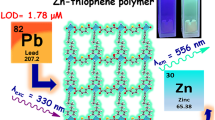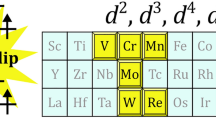Abstract
Seven useful mixed-ligand complexes in the form of [Ir(terpy)(L)Cl]2+ were prepared and their spectroscopic and electrochemical properties were investigated. The ligands used were terpy = 2,2′:6′,2″-terpyridine, L = 2,2′-bipyridine, 4,4′-dimethyl-2,2′-bipyridine, 4,4′-diphenyl-2,2′-bipyridine, 1,10-phenanthroline, 5-phenyl-1,10-phenanthroline, 4,7-diphenyl-1,10-phenanthroline, 2,3-bis(2-pyridyl)pyrazine. Synthetic methods were developed by a sequential ligand-replacement which occurred in the reaction vessel using a microwave oven. All complexes showed that LUMOs are based on the π-system contribution of the terpyridine ligand for [Ir(terpy)(bpy)Cl]2+, [Ir(terpy)(dmbpy)Cl]2+, [Ir(terpy)(dpbpy)Cl]2+, [Ir(terpy)(phen)Cl]2+, [Ir(terpy)(dpphen)Cl]2+ and [Ir(terpy)(phphen)Cl]2+. On the other hand, the LUMO in the [Ir(terpy)(bppz)Cl]2+ complex is localized on the π-system of the bppz ligand, whereas the HOMOs in the iridium complexes are localized on the terpyridine ligand. It was found that Ir(terpy)(L)Cl emits in a fluid solution at room temperature. The ancillary ligands, such as terpy and bpy, have been explored to extend the lifetime of the triplet 3(π–π*) excited states of Ir(III) terpyridine complexes. Ir(III) terpyridine units with an electron donor (dmbpy) or electron acceptor substituents (terpy, dpbpy, phphen, dpphen and bppz) are found to decrease the energy of the 3LC states for use as photosensitizer molecular components in supramolecular devices. The spectroscopic and electrochemical details are also reported herein.
Similar content being viewed by others
References
L. M. Volgler and K. J. Brewer, Inorg. Chem., 1996, 35, 818.
J. A. Treadway, B. Loeb, R. Lopez, P. A. Anderson, F. R. Keene, and T. J. Meyer, Inorg. Chem., 1996, 35, 2242.
S. Lamansky, P. Djurovich, D. Murphy, F. Abdel-Razzaq, R. Kwong, I. Tsyba, M. Bortz, B. Mui, R. Bau, and M. E. Thompson, Inorg. Chem., 2001, 40, 1704.
S. Lamansky, P. Djurovich, D. Murphy, F. Abdel-Razzaq, H. E. Lee, C. Adachi, P. E. Burrows, S. R. Forrest, and M. E. Thompson, J. Am. Chem. Soc., 2001, 123, 4304.
F. Neve, A. Crispini, S. Campagna, and S. Serroni, Inorg. Chem., 1999, 38, 2250.
T. Yukata, I. Mori, M. Kurihara, J. Mizutani, K. Kubo, S. Furusho, K. Matsumura, N. Tanai, and H. Nishihara, Inorg. Chem., 2001, 40, 4986.
A. Dovletoglou, S. A. Adeyemi, and T. J. Meyer, Inorg. Chem., 1996, 35, 4120.
S. M. Zakeeruddin, M. K. Nazeeruddin, P. Pechy, F. P. Rotzinger, R. Humphry-Baker, K. Kalyanasundaram, and M. Gratzel, Inorg. Chem., 1997, 36, 5937.
A. B. P. Lever, Inorg. Chem., 1990, 29, 1271.
P. Didier, I. Otmans, A. Kirsch-De Mesmaeker, and R. J. Watts, Inorg. Chem., 1993, 32, 5239.
S. S. Fielder, M. C. Osborne, A. B. P. Lever, and W. J. Pietro, J. Am. Chem. Soc., 1995, 117, 6990.
J. V. Casper and T. J. Meyer, Inorg. Chem., 1983, 22, 2444.
P. A. Anderson, L. F. Anderson, M. Furue, P. C. Junk, F. R. Keene, B. T. Patterson, and B. D. Yeomans, Inorg. Chem., 2000, 39, 2721.
N. Yoshikawa, Y. Masuda, and T. Matsumura-Inoue, Chem. Lett., 2000, 1206.
J. P. Collin, I. M. Dixon, J. P. Sauvage, J. A. G. Williams, F. Barigelletti, and L. Flamigni, J. Am. Chem. Soc., 1999, 121, 5009.
N. P. Ayala, C. M. Flynn, L. Sacksteder, J. N. Demas, and B. A. Degraff, J. Am. Chem. Soc., 1990, 112, 3837.
C. J. Timpson, C. A. Bignozzi, B. P. Sullivan, E. M. Kober, and T. J. Meyer, J. Phys. Chem., 1996, 100, 2915.
M. T. Indelli, C. A. Bignozzi, and F. Scandola, Inorg. Chem., 1998, 37, 6084.
Author information
Authors and Affiliations
Corresponding author
Rights and permissions
About this article
Cite this article
Yoshikawa, N., Matsumura-Inoue, T. Electrochemical and Phosphorescent Properties of New Mixed-Ligand Ir(III) Complexes Coordinated with Both Terpyridine and Various Bipyridine Derivatives. ANAL. SCI. 19, 761–765 (2003). https://doi.org/10.2116/analsci.19.761
Received:
Accepted:
Published:
Issue Date:
DOI: https://doi.org/10.2116/analsci.19.761




